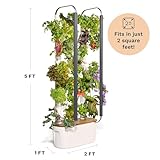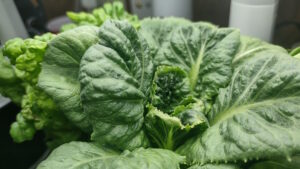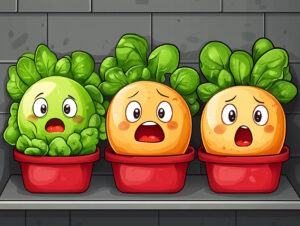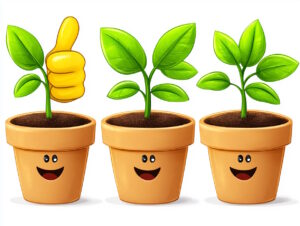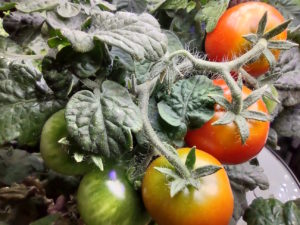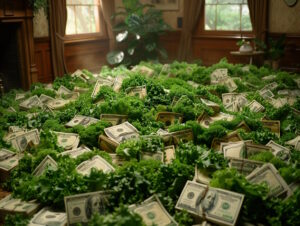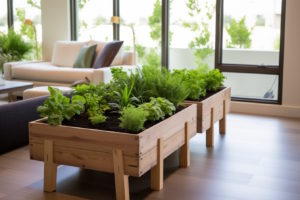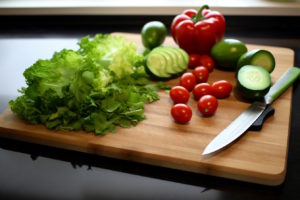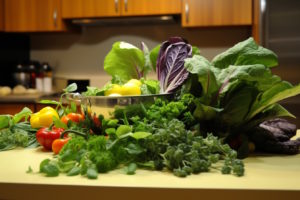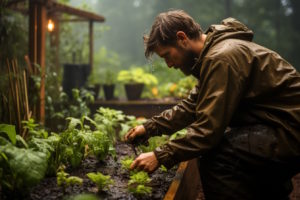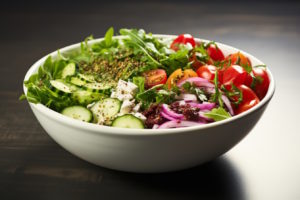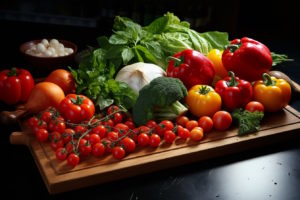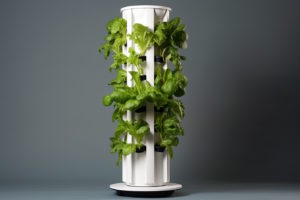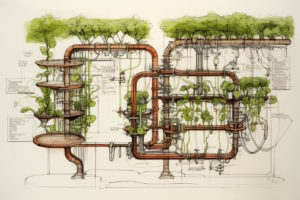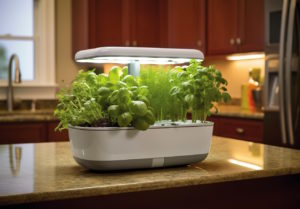Limited Floor Space? Go Vertical With Your Garden!
Want to grow your garden indoors, but tight on space? Or maybe you want to increase your harvest without taking up more room. You’re missing great opportunities by limiting yourself to a horizontal garden indoors.
Go vertical! Stack your plants to reduce your garden’s footprint. Vertical gardens are such a nifty idea.
What is a Vertical Garden?
A vertical garden is a system of planting where the plants are arranged vertically rather than horizontally. A traditional in-ground or raised-bed garden is a horizontal garden. Plants grow side-by-side. In a vertical garden, plants grow stacked one above another. A primary objective for building a vertical garden is minimizing the amount of floor space the garden takes up.
Vertical gardens can be grouped into three categories.
- Wall garden
- Rack garden
- Column (or tower) garden
One or more of these vertical gardens probably suits your planned indoor garden.
Wall Garden
A wall garden is, unsurprisingly, a garden on a wall. Planters, either solid or fabric, are attached to a wall in a decorative or space-efficient manner. Decorative planters might be small pots meant for small plants, separated but arranged in a pattern. Fabric planters are a single unit with one to nearly a hundred baskets arranged in a grid.
Some herbs or strawberries may be grown in wall-mounted planters for decoration and utility. But beware of wall gardens unsuitable for an indoor food garden; water leaking through a fabric pocket will flow down your wall.
Drainage and spillage are limiting factors in construction of a wall garden, at least if done indoors. Overfilling the pocket or pail results in water spilling over the edge onto the floor. The water needs a way to drain without causing a puddle on the floor. Leaving water in the pocket or pail may damage the roots.
Lighting a wall garden is challenging. The light assembly must extend out from the wall and be powerful enough to cover the wall. Light assemblies that protrude from the wall increase the profile of a wall garden.
Used outdoors, where many plants can grow in a vertical sheet of planters, a wall garden has potential. Mounting a wall garden to a stockade fence makes efficient use of wasted space. The entire garden can be watered with a garden hose and any excess water can wash down the side of the fence.
Sunlight on a wall garden is the optimal light source.
Weight is a consideration for a wall garden. Soil is heavy and wet soil is heavier. You’ll need a secure wall anchor. Not a consideration indoors, but the wind can cause an improperly secured wall garden to flap around.
This model occupies almost no floor space.
Rack Garden
With racks, you can preserve floor space by stacking your plants on multiple levels. Racks are essentially layers of horizontal gardens. A rack can be a lighted shelf or a hydroponic tube or hydroponic shelf.
Shelves of Potted Plants
Open access shelves paired with grow lights mounted under each shelf provide an efficient use of floor space. You can grow as many plants as will fit on the lit shelves and store supplies on the unlit top shelf.
However, you have to water these plants, and the runoff must be managed. Every container must have a water retention system—at minimum, a tray.
Open bottom planters are best done outdoors. Shelves of potted plants require a water management system to be self-watering. The water management system must include a filtration system to screen out dirt particles to allow for reliable water circulation.
Shelves perform best when you have a variety of plant projects going on and need a dedicated space to keep them. Seedling trays take up much room and shelves help clear up many a counter top.
Hydroponic Pipes
You’ll be amazed how many plants fit on a single rack in a hydroponics rig. These assemblies excel at growing an abundance of leafy greens or similar plants.
You’ll use no soil in a rack-based hydroponic system. Plants grow up from holes drilled in a PVC pipe laid horizontally but at a slight angle to encourage water flow. Roots feed from water mixed with nutrients. The water passes through the PVC pipe at regular intervals rather than remaining stationary. Light for the plants comes from grow lights mounted above each rack.
The process is simple. You fill a large bucket with water. An electric pump pushes water to the top rack and gravity draws the water down through pipes connecting the racks until it finally ends up back in the bucket.
Compared to a shelve-based rack, your involvement is minimal with a hydroponics system. Once the system is running, you just monitor the water level and nutrients. Timers control the light and pump schedules for you.
Set-up is more involved than a countertop garden with grow sponges in pods. You’ll start your seeds elsewhere until they are seedlings a few inches tall. You’ll mount the seedlings in a cube of rockwool or like material, put the rockwool in a netting cup, and place the cup in a hole in the PVC pipe. This rig lacks the per-plant water circulation system you’ll find in the typical Hydroponic Growing System.
Racks of hydroponic pipes are a very space-efficient garden. They can be used indoors or outdoors. The system is low-maintenance once it’s running and you can swap out plants quickly. A worthy addition to a high-volume indoor garden.
Column Garden
The column garden combines high capacity with minimal footprint. This style of vertical garden resembles a circular column with plants sprouting out all sides of it. That’s because it actually is a hollow column with plants sprouting out of it.
Whereas a PVC pipe laid horizontally can only grow plants out its top edge, a PVC pipe stood upright like a column can grow plants all the way around and all the way up. This is a very efficient use of space. This model takes up only as much floor space as is needed for the water reservoir feeding the plants growing from the column.
The plants you grow are directly accessible; you don’t have to push a plant aside to access another. Plants grow up and out, but also down. Lettuce and herbs will grow up and out toward the lights aimed at the column.
But tomatoes and cucumbers will suspend their branches out and down from their position on the column. You can get creative with a trellis to manage branches and encourage more growth.
A vertical garden is a hollow column with 2 inch holes cut in its walls on all sides for most of its height. Plants grow in netting cups set in the holes. Rockwool cubes {paid link} secure the plants in the cups. A large enclosed tub serves as a water reservoir and base for the column.
A water circulation system pushes water from the basin to the top of the column. Water cascades down, washing over the roots, or is distributed to the roots as a mist. This system is better described as aeroponics than hydroponics, because the roots don’t stay submerged in water.
Lighting for a column vertical garden comes from LED grow lights mounted vertically to face the entire height of the column. A set of four lights is probably the fewest number of lights required to supply all the plants adequately. Timers control the water flow and lighting.
The column makes for an especially compact garden. The column garden configuration really suits a small apartment or house, where counter and floor space is scarce.
A column makes economical use of its space. If four plants ring the column, and the column has eight rings covering its entire height, the capacity of that one column is thirty-two plants. All at the reasonable cost of a few square feet of floor space. Some columns rotate rings slightly from the ring directly below, so as to allow plants of each ring to grow up between the plants of the ring above.
The column typically anchors on the lid of a large water reservoir that doubles as an weighted base to keep it from tipping. A circulation system powered by an electric pump submerged in the basin pushes water to the top of the column.
Vertical columns do very well outdoors. The sun eliminates the need for artificial light, but a pump still requires electricity to push water to the top of the tower. However, an outdoor column garden that uses soil instead of hydroponics gets sunlight and rainwater (or water from a hose), so electric power is unnecessary. Column gardens are so adaptable!
What Can I Grow in a Vertical Garden?
Each type of vertical garden has its unique characteristics. What you can grow depends on the style you choose.
Wall Garden
A fabric wall garden is mostly decorative but handy if your wish list of fresh herbs is short and those herbs happen to pair well with the small wall garden containers. Strawberries are listed as good for wall gardens. Smaller leafy greens should work well if care is taken to select suitable containers.
Rack Garden
A rack garden with shelves is highly versatile but hardly automated. Automation is typically limited to lighting. This works well for starting seeds in bulk trays. Trays take a lot of counter real estate, so shelves are your friends here. Shelves will grow whatever fits on them.
If you have a plant that sends out long vines like a cucumber, the rack doubles as a trellis and the vines will get the benefit of lights on other shelves as they grow. You might want to start the plant in a container large enough you won’t have to re-pot it later.
The rack garden provides the environment for growing root-based plants like carrots and potatoes. These can be grown indoors, but water drainage must be considered.
Hydroponic Pipes
Hydroponic pipes support growing almost any leafy green, herb, or vegetable. However, the advantage of hydroponic pipes comes from growing plants in close proximity from a single water reservoir. Smaller plants such as lettuce or herbs benefit the most from this arrangement.
The hydroponic pipes system shines in growing a high volume crop of like plants. The density of plants on the rack promotes planting all at once and harvesting all at once. Think assembly line more than clippings for tonight’s dinner.
Column Gardens
You can grow probably any leafy green and herb and most vegetables with a column garden. Chief considerations include weight and bulk of the plant. A zucchini plant might be a bit too much for the column, but the column could handle a tomato plant well enough.
A column garden could get top-heavy depending on what is planted, especially if the basin runs low of water.
Weight issues aside, you can grow green beans, peas, tomatoes, peppers, cucumbers and more with a column garden.
What are Some Pros and Cons of Column Gardens?
All the types of vertical garden have pros and cons. However, except for the column gardens, the vertical gardens discussed above are decorative or simply more efficient use of horizontal space. Plants in these garden systems grow just like a plant growing in the dirt outdoors, only better.
Column gardens are the outliers. Aeroponics? Plants growing above each other on a vertical plane? That’s original. Let’s dig a little deeper there. What are some general pros and cons to column gardens?
Pros
For indoor gardens, vertical gardens are spectacular space-savers. What are some other positive attributes of starting a vertical garden indoors?
- 360° lighting versus down-facing light
- Branching plants hanging down don't need a trellis like on a horizontal planter
- Plants have more room to grow vertically without a light hovering overhead
- Plant are less crowded horizontally due to curvature of the column
- You can clean the water reservoir without disturbing plants on column
- Larger water reservoir means less time spent maintaining it
- Highly efficient use of water, especially versus growing in soil outdoors
Cons
Column gardens have their down side. Here are a few observations.
- Equipment is generally more expensive per plant site than horizontal garden
- Can tip if column is improperly attached to base
- Too tall for children to manage without a stepstool
- Start seeds elsewhere and transplant as seedlings
Any Special Considerations for a Column Garden?
If you have an interest in column gardening, here are a few points to consider.
- Wheels on the base allow for easy rotation and relocation
- The wider the base, the more stable the garden, but the more floor space committed
- Wrapping your column garden in a tarp maximizes light on your plants
- A column garden enclosed in a tarp benefits from having a fan provide airflow
- Multiple lights means multiple power plugs
- Can add plants through reservoir lid to increase yield
- Can add a pump to water reservoir to quickly empty for routine maintenance
Key Takeaways
Vertical gardening opens vast opportunities for growing food indoors. You can increase your garden yield by stacking racks of planters or employing towering planters. Think in three dimensions! There’s so much wasted space between the top of a plant in a container and the ceiling.
Look around your house for corners or unused floor space where you can add a tall garden. Chances are, you’ll find places that one or more of the vertical gardens discussed above will fit perfectly.
Amazon recently introduced “Amazon Haul”, and you might find gardening bargains here. “Haul” is still in Beta, meaning it may change or go away entirely, so don’t delay.
You’ll have to poke around a bit to find products to help with your indoor garden. Give it a try!
Check out “Amazon Haul” [affiliate link] now.
You Have A New Hydroponic Growing System. Now What?
You have a new indoor garden and high hopes. What do you do next?
Keep ReadingSurviving in a Post-AeroGarden World
AeroGarden announced its closing effective the first of January, 2025. Farewell, good friend.
Keep ReadingThe Most Reviewed Indoor Gardening Equipment
You don’t get thousands or tens of thousands of reviews by being a horrible product. What works? Find out here.
Keep Reading32 Factors to Consider When Setting Up Your Indoor Garden
Avoid making simple mistakes when you set up your indoor garden.
Keep ReadingYou Can Grow Tomatoes Indoors
You can grow delicious tomatoes indoors all year long, and it’s actually quite easy. Get started now!
Keep ReadingIs Indoor Gardening Expensive?
Is gardening indoors expensive? Relatively, no.
Keep ReadingA Raised Bed Garden Indoors? Bring It On!
Learn how to grow your food indoors using an indoor garden bed.
Keep ReadingTips For Growing A Bountiful Indoor Garden
Make your life easier and grow more food indoors with these tips, tricks, and suggestions.
Keep ReadingHow to Choose Your Hydroponic Growing System
Ready to buy a hydroponic growing system, but not sure what features matter? Start here!
Keep ReadingHow to Plan Your Indoor Garden
Get more from your indoor garden by gardening with a purpose.
Keep ReadingIndoor Gardens Aren’t Outdoor Gardens Indoors
When you grow your garden indoors, you leave the old traditions and limitations outdoors.
Keep ReadingHow to Get a Salad Every Day from Your Indoor Garden
You can grow an indoor salad all year long. Learn how!
Keep ReadingWhat Can I Grow with My Indoor Garden?
Spoiler alert: Almost anything! This is a LONG list. And it’s really easy.
Keep ReadingLimited Floor Space? Go Vertical With Your Garden!
Learn about vertical indoor gardens and discover your options.
Keep ReadingHow a Self-Watering Hydroponic System Works
Get the best self-watering hydroponic system by learning how they work.
Keep ReadingWhy Your Outdoor Garden Should Be Indoors
Bring your garden indoors for year-round produce without the back-aches.
Keep Reading




